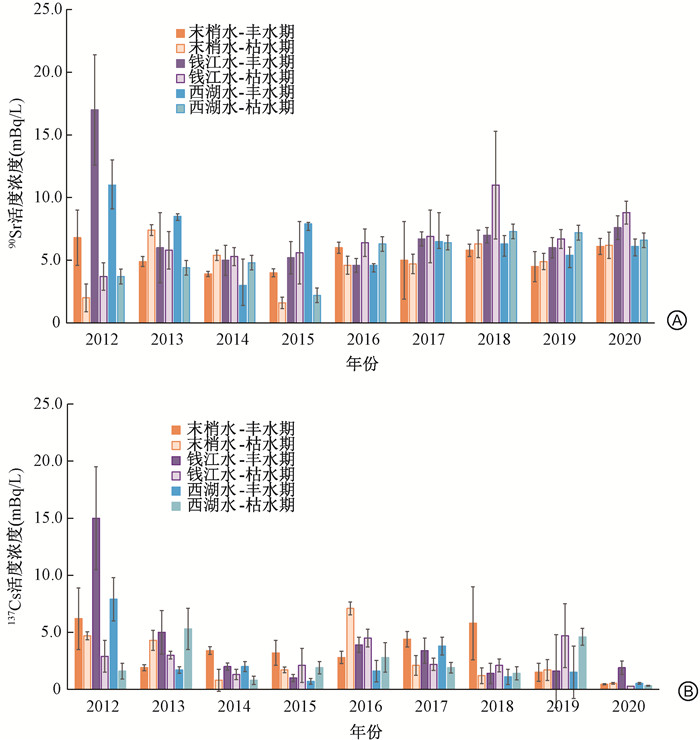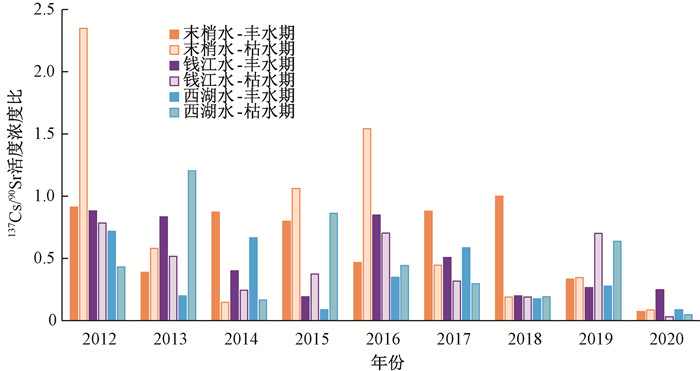90Sr和137Cs是核设施运行、核事故以及核武器试验释放的两种重要的裂变产物[1],其半衰期较长(分别为28.79和30.17年),一旦进入环境可长期存在。另外,90Sr和137Cs进入生物体后可在骨骼和肌肉组织中富集[2-3]。因此,在居民辐射安全评估中,90Sr和137Cs是两个非常关键的放射性核素[4-8]。饮水是90Sr和137Cs进入人体的重要途径,因此, 持续监测水中的90Sr和137Cs对于确保居民的辐射安全至关重要。目前,在全球范围内持续监测水中90Sr和137Cs是开展辐射安全风险评估的普遍做法[9-11]。
杭州市距秦山核电站和三门核电站的直线距离分别不到100和200 km。核电站的正常运行产生的放射性废物,对杭州市区水质的潜在影响越来越引起人们的关注。本研究自2012年起,对杭州市的重要水源钱塘江下游段、人群密集热门景点西湖(如2018年接待游客2 813.94万人次[12],政府高度关注西湖水质及环境,西湖水主要来自钱塘江水且每个月交换一次)以及杭州市末梢水进行了长达9年的监测,为开展辐射风险评估提供数据参考。
材料与方法1. 样品采集:分别在浙江省疾病预防控制中心(北纬30°11′37″,东经120°10′4″)设置末梢水(水源为钱塘江水)采样点1个,钱塘江下游(北纬30°12′18″,东经120°10′9″)设置钱塘江水采样点1个,西湖(北纬30°15′29″,东经120°9′10″)设置西湖水采样点1个,分别在丰水期(5月)和枯水期(11月)采样,其中钱塘江和西湖均采集表层水,每个采样点每次采集3份水样,每份采集60 L。采样点设置后通过全球定位系统(GPS)定位确保每次采样均在同一位置。
2. 仪器:低本底总α总β测量仪为BH1217Ⅱ型四路低本底α β测量仪(北京核仪器厂),LB790十通道低本底α β计数器(德国Berthold科技公司)。
3. 水样处理和检测方法
(1) 90Sr测定:取水样30 L,用硝酸调节pH为1.0,分别加入锶和钇载体后,用氨水调节pH至8.0,加入240 g碳酸铵,水样加热至将近沸腾,使沉淀凝聚,弃去上清液。沉淀用1% 碳酸铵溶液洗涤后,6 mol/L硝酸溶液溶解,用氨水调节pH至1.5。溶液以2 ml/min的流速通过装有二-(2- 乙基己基)磷酸的色层柱吸附钇,记录开始过柱和过柱结束时间。用40 ml 1.5 mol/L硝酸以2 ml/min的流速淋洗色层柱。用30 ml 6 mol/L硝酸以1 ml/min的流速洗脱钇。向洗脱液加入5 ml饱和草酸溶液,用氨水调节pH至2.0,制得草酸钇沉淀形式的钇。将草酸钇沉淀干燥并称量,按草酸钇的分子式计算钇的化学回收率后,用低本底总α总β测量仪测量草酸钇沉淀[13-14]。该条件下方法检出限为0.2 mBq/L。
(2) 137Cs测定:取水样30 L,用硝酸调节pH<3.0后加入铯载体,加入6 g磷钼酸铵,搅拌后放置澄清12 h以上。虹吸弃去上清液,剩余溶液抽滤后,保留沉淀弃去滤液。用60 ml 2 mol/L氢氧化钠溶液溶解沉淀,抽滤,滤液加水稀释后加入6 g固体柠檬酸和10 ml浓硝酸。加入0.8 g磷钼酸铵,抽滤,分离吸附铯的磷钼酸铵。加入10 ml 2 mol/L氢氧化钠溶解磷钼酸铵粉末,再次过滤。滤液中加入5 ml柠檬酸钠溶液(质量分数为30%),蒸发溶液至5 ~ 8 ml,冰水浴冷却,然后加入2 ml冰乙酸和2.5 ml碘铋酸钠溶液,冰水浴冷却,最终分离出的铯为碘铋酸铯沉淀。将碘铋酸铯沉淀干燥并称量,以碘铋酸铯的形式计算铯的化学回收率,用低本底总α总β测量仪对沉淀进行测定[15-16]。该条件下方法检出限为0.2 mBq/L。
4. 质量保证:本研究使用的低本底总α总β测量仪,检测样品之前均使用电镀源校准效率、标准源刻度效率,本底测量周期和测量时间与样品检测一致。所用仪器设备均在检定周期内,检定合格。水中137Cs和水中90Sr的测量方法均通过计量认证和国家实验室认可。样品分析时同步实施平行双样分析和加标实验。
5. 统计学处理:采用SPSS 25.0软件进行统计分析,Mann-Whitney U检验用于比较水中90Sr和137Cs活度浓度的差异性。P < 0.05为差异具有统计学意义。
结果1. 90Sr和137Cs活度浓度:2012—2020年杭州市区水中90Sr和137Cs活度浓度结果见图 1。末梢水中90Sr和137Cs的活度浓度范围分别为(2.0±1.1)~(7.4±0.4)mBq/L, (0.45±0.06)~(7.1±0.6)mBq/L;钱塘江水中90Sr和137Cs的活度浓度范围分别为(3.7±1.1)~(17.0± 4.4)mBq/L,(0.28±0.01)~(15.0±4.5)mBq/L;西湖水中90Sr和137Cs的活度浓度范围分别为(2.2± 0.5)~(11.0±2.0)mBq/L,(0.32±0.04)~(7.9±1.9)mBq/L。对于137Cs的活度浓度,不同水体间差异无统计学意义(P > 0.05)。对于90Sr的活度浓度,除了钱塘江水与末梢水差异有统计学意义(Z=-2.42,P = 0.015)外,其他水体之间差异均无统计学意义(P > 0.05)。

|
图 1 2012—2020年杭州市区水中90Sr(A)和137Cs(B)活度浓度 Figure 1 90Sr (A) and 137Cs (B) activity concentrations in water in Hangzhou urban area from 2012 to 2020 |
2. 137Cs/90Sr活度比值:2012—2020年杭州市区水中137Cs/90Sr活度比值见图 2。末梢水中137Cs/90Sr活度比值范围为0.07 ~ 2.40;钱塘江水中137Cs/90Sr活度比值范围为0.03 ~ 0.90;西湖水中137Cs/90Sr活度比值范围为0.05 ~ 1.20。除了2012年枯水期末梢水的137Cs/90Sr活度比值为2.40之外,其余水体的137Cs/90Sr活度比值均≤1.50。

|
图 2 2012—2020年杭州市区水中137Cs/90Sr活度比值 Figure 2 The 137Cs to 90Sr activity ratio in water Hangzhou urban area from 2012 to 2020 |
讨论
根据统计学结果显示,除了钱塘江水中90Sr的活度浓度显著高于末梢水外,各水体之间无论是90Sr还是137Cs的活度浓度差异均无统计学意义(P > 0.05)。末梢水采样点采集的水,来源于钱塘江,出现差异可能是自来水的处理过程导致的,例如混凝、过滤、沉淀等处理步骤[17]。在2012年,丰水期和枯水期采集的西湖水中90Sr活度浓度差高达3.0倍,钱塘江水中137Cs的活度浓度差更是达到了5.2倍。这可能是由于水体物理和化学性质等差异导致90Sr和137Cs在水中的分散/迁移行为发生变化[18]。137Cs活度浓度的波动幅度大于90Sr,9年来3种水体中137Cs活度浓度最大值和最小值相差均超过15倍,而90Sr相差最大的也仅5.0倍,这可能与两者挥发性不同有关[19]。
2012—2020年间,各类水体中90Sr和137Cs活度浓度均没有明显的时间趋势,监测结果与世界范围内不同水域的放射性水平处于同一量级水平,远低于世界卫生组织建议的浓度限值[20](90Sr和137Cs的限值均为10 Bq/L)。2013年三门核电站宁海毗邻区水体中90Sr和137Cs活度浓度分别为4.76 ~ 9.02和2.23~9.32 mBq/L[21];1999—2001年格陵兰岛陆地淡水中90Sr和137Cs活度浓度范围分别为1.62 ~ 5.17和0.27 ~ 2.41 mBq/L[22];2010—2012年对海阳核电站周围饮用水中90Sr活度浓度范围为1.21 ~ 9.12 mBq/L[23]。
地表中90Sr和137Cs的主要来源是既往大气层核武器试验和核事故(如切尔诺贝利核事故和福岛核事故)带来的全球放射性沉降物[24-27]。本研究区域内90Sr和137Cs的来源还应考虑当地的核设施可能带来的污染,主要是三门核电站、秦山核电站等。到目前为止,未发现三门核电站和秦山核电站有明显的放射性释放的报道。因此,可以推断在杭州采集的水样中检测到的90Sr和137Cs主要来源于既往大气层核武器试验及核事故带来的全球放射性沉降。
137Cs/90Sr活度比可用于分析这些放射性核素的来源。如,福岛核事故和切尔诺贝利核事故发生后,大气沉降物中137Cs/90Sr活度比最高分别达到1 000和250,远高于正常值[28-29]。若某区域内地表中137Cs和90Sr主要来源于既往大气层核武器试验及核事故带来的全球放射性沉降,那么该区域淡水样品中137Cs/90Sr活度比应该是低于全球放射性沉降物的137Cs/90Sr活度比,因为137Cs更容易吸附和固定在土壤上,而90Sr则表现出更高的流动性更容易往水体中迁移[30]。2012—2020年,杭州天然水体(西湖水和钱塘江水)中137Cs/90Sr活度比均不大于1.5,低于全球放射性沉降物的137Cs/90Sr活度比(约1.6)[25],这个结果符合杭州水中90Sr和137Cs主要来源于既往大气层核武器试验及核事故带来的全球放射性沉降这一推断。另外,同一采样点水中137Cs/90Sr比值的最大值和最小值相差较大,而且最小值基本都出现在2020年,这可能与2020年的降水量较多有关[31],降水量增加导致土壤中具有更高流动性的90Sr更多的向水体中迁移。
本研究连续9年对杭州市区水体中90Sr和137Cs的放射性水平进行监测,并对其变化和来源情况进行分析,获得的数据均为本底水平。未来,将继续监测杭州市区水中90Sr和137Cs放射性水平,增加样本采集范围,为杭州市居民的辐射安全评估提供更多的数据支持,并将90Sr和137Cs监测,特别是137Cs/90Sr活度比作为防止本地意外放射性输入的保障措施。
利益冲突 无
志谢 感谢浙江省疾病预防控制中心疾控英才孵育项目对本研究的资助;感谢杭州市疾病预防控制中心张文辉、舒丽萍、徐虹、张力群等的支持
作者贡献声明 王鹏负责组织实验、论文撰写和修改;曹艺耀负责组织实验、数据分析、论文修改和定稿,任鸿负责样品处理、检测;周磊、俞顺飞、赵尧贤、赖忠俊、宣志强负责水样采集;邹华负责组织协调
| [1] |
Miki S, Fujimoto K, Shigenobu Y, et al. Concentrations of 90Sr and 137Cs/90Sr activity ratios in marine fishes after the Fukushima Dai-ichi nuclear power plant accident[J]. Fish Oceanogr, 2017, 26(2): 221-233. DOI:10.1111/fog.12182 |
| [2] |
Whicker FW, Nelson WC, Gallegos AF. Fallout 137Cs and 90Sr in trout from mountain lakes in Colorado[J]. Health Phys, 1972, 23(4): 519-527. DOI:10.1097/00004032-197210000-00009 |
| [3] |
Young DR, Folsom TR. Caesium accumulation in muscle tissue of marine fishes[J]. Health Phys, 1979, 37(5): 703-706. DOI:10.1080/00087114.1979.10796773 |
| [4] |
Miao XX, Ji YQ, Shao XZ, et al. Radioactivity of drinking-water in the vicinity of nuclear power plants in China based on a large-scale monitoring study[J]. Int J Environ Res Public Health, 2013, 10(12): 6863-6872. DOI:10.3390/ijerph10126863 |
| [5] |
Merz S, Shozugawa K, Steinhauser G. Analysis of Japanese radionuclide monitoring data of food before and after the Fukushima nuclear accident[J]. Environ Sci Technol, 2015, 49(5): 2875-2885. DOI:10.1021/es5057648 |
| [6] |
Falandysz J, Saniewski M, Zhang J, et al. Artificial 137Cs and natural 40K in mushrooms from the subalpine region of the Minya Konka summit and Yunnan Province in China[J]. Environ Sci Pollut Res Int, 2018, 25(1): 615-627. DOI:10.1007/s11356-017-0454-8 |
| [7] |
Falandysz J, Zhang J, Saniewski M. 137Cs, 40K, and K in raw and stir-fried mushrooms from the Boletaceae family from the Midu region in Yunnan, Southwest China[J]. Environ Sci Pollut Res Int, 2020, 27(26): 32509-32517. DOI:10.1007/s11356-020-09393-w |
| [8] |
Ishii Y, Matsuzaki SS, Hayashi S. Data on 137Cs concentration factor of freshwater fish and aquatic organisms in lake and river ecosystems[J]. Data Brief, 2020, 28: 105043. DOI:10.1016/j.dib.2019.105043 |
| [9] |
Suplińska M, Kardaś M, Rubel B, et al. Monitoring of radioactive contamination in Polish surface waters in 2012-2013[J]. J Radioanal Nucl Chem, 2015, 304(1): 81-87. DOI:10.1007/s10967-014-3728-3 |
| [10] |
Shimura T, Yamaguchi I, Terada H, et al. Public health activities for mitigation of radiation exposures and risk communication challenges after the Fukushima nuclear accident[J]. J Radiat Res, 2015, 56(3): 422-429. DOI:10.1093/jrr/rrv013 |
| [11] |
Van TT, Bat LT, Nhan DD, et al. Estimation of radionuclide concentrations and average annual committed effective dose due to ingestion for the population in the Red River Delta, Vietnam[J]. Environ Manage, 2019, 63(4): 444-454. DOI:10.1007/s00267-018-1007-8 |
| [12] |
尹彦鑫. 2018十大年度人气景区西湖居首年接待游客2813.94万人次[EB/OL]. (2019-03-20)[2023-03-10]. http://news.bandao.cn/a/211164.html. Yin YX. West Lake is the most popular scenic spot in 2018, with 28.1394 million tourists annually[EB/OL]. (2019-03-20)[2023-03-10]. http://news.bandao.cn/a/211164.html. |
| [13] |
国家环境保护局. GB 6766-1986水中锶-90放射化学分析方法二-(2-乙基已基)磷酸酯萃取色层法[S]. 北京: 中国标准出版社, 1986. National Environmental Protection Administration. GB 6766-1986 Radiochemical analysis of strontium-90 in water Extraction chromatography by di-(2-ethylhexyl) phosphoric acid: GB 6766-1986[S]. Beijing: Standards Press of China, 1986. |
| [14] |
环境保护部. HJ 815-2016水和生物样品灰中锶-90的放射化学分析方法[S]. 北京: 中国标准出版社, 2016. Ministry of Environmental Protection. HJ 815-2016 Radiochemical analysis of strontium-90 in water and ash of biological samples[S]. Beijing: Standards Press of China 2016. |
| [15] |
国家环境保护局. GB 6767-1986水中铯-137放射化学分析方法[S]. 北京: 中国标准出版社, 1986. National Environmental Protection Administration. GB 6767-1986 Radiochemical analysis of caesium-137 in water[S]. Beijing: Standards Press of China, 1986. |
| [16] |
环境保护部. HJ 816-2016水和生物样品灰中铯137的放射化学分析方法[S]. 北京: 中国标准出版社, 2016. Ministry of Environmental Protection. HJ 815-2016 Radiochemical analysis of caesium-137 in water and ash of biological samples[S]. Beijing: Standards Press of China, 2016. |
| [17] |
任鸿, 曹艺耀, 王鹏, 等. 千岛湖供水对杭州市主城区饮用水中总放射性水平的影响[J]. 中华放射医学与防护杂志, 2022, 42(6): 438-442. Ren H, Cao YY, Wang P, et al. Impact of water supply from Qiandao Lake on gross radioactivity level in drinking water in downtown Hangzhou[J]. Chin J Radiol Med Prot, 2022, 42(6): 438-442. DOI:10.3760/cma.j.cn112271-20220127-00037 |
| [18] |
Jiménez A, Rufo MDLM. Influence of physicochemical characteristics of freshwater on artificial radioactivity content[J]. Water Environ Res, 2001, 73(3): 286-294. DOI:10.2175/106143001x139290 |
| [19] |
Nuclear Emergency Response Headquarters, Government of Japan. Report of Japanese Government to the IAEA Ministerial Conference on Nuclear Safety-The accident at TEPCO's Fukushima Nuclear Power Stations[R]. Vienna: IAEA, 2011.
|
| [20] |
World Health Organization. Guidelines for drinking-water quality, 4th ed[R]. Geneva: WHO, 2011.
|
| [21] |
胡丹标, 芦丽嫦, 胡艳敏, 等. 三门核电站宁海毗邻区域辐射水平本底调查[J]. 上海预防医学, 2016, 28(4): 214-218. Hu DB, Lu LC, Hu YM, et al. Survey of radiation baseline level in Ninghai areas adjacent to the Sanmen nuclear power station[J]. Shanghai J Prev Med, 2016, 28(4): 214-218. DOI:10.19428/j.cnki.sipm.2016.04.002 |
| [22] |
Dahlgaard H, Eriksson M, Nielsen SP, et al. Leves and trends of radioactive contaminants in the Greenland environment[J]. Sci Total Environ, 2004, 331(1-3): 53-67. DOI:10.1016/j.scitotenv.2001.03.023 |
| [23] |
杨昕, 陈英明, 许家昂, 等. 海阳核电站周围居民饮用水中锶-90放射性水平调查与卫生学评价[J]. 中国辐射卫生, 2014, 23(3): 193-197. Yang X, Chen YM, Xu JA, et al. Investigation and analysis of strontium concentration of drinking-water surrounding Haiyang nuclear power plant[J]. Chin J Radiol Health, 2014, 23(3): 193-197. DOI:10.13491/j.cnki.issn.1004-714x.2014.03.001 |
| [24] |
United Nations Scientific Committee on the Effects of Atomic Radition. Sources and effects of ionizing radiation[R]. New York: UNSCEAR, 2000.
|
| [25] |
Krey PW, Krajewsky B. Comparison of atmospheric transport model calculations with observations of radioactive debris[J]. J Geophys Res(Part C: Oceans), 1970, 75(15): 2901-2908. DOI:10.1029/JC075i015p02901 |
| [26] |
Aoyama M, Hirose K. The temporal and spatial variation of 137Cs concentration in the Western North Pacific and its marginal seas during the period from 1979 to 1988[J]. J Environ Radioact, 1995, 29(1): 57-74. DOI:10.1016/0265-931X(94)00050-7 |
| [27] |
Ikeuchi Y, Amano H, Aoyama M, et al. Anthropogenic radionuclides in seawater of the Far Eastern Seas[J]. Sci Total Environ, 1999, 237-238: 203-212. DOI:10.1016/s0048-9697(99)00136-9 |
| [28] |
Castrillejo M, Casacuberta N, Breier CF, et al. Reassessment of 90Sr, 137Cs, and 134Cs in the coast off Japan derived from the Fukushima Dai-ichi nuclear accident[J]. Environ Sci Technol, 2016, 50(1): 173-180. DOI:10.1021/acs.est.5b03903 |
| [29] |
Irlweck K, Khademi B, Henrich E, et al. 239(240), 238Pu, 90Sr, 103Ru and 137Cs concentrations in surface air in Austria due to dispersion of Chernobyl releases over Europe[J]. J Environ Radioact, 1993, 20(2): 133-148. DOI:10.1016/0265-931X(93)938-9 |
| [30] |
Miller JR, Reitemeier RF. The leaching of radiostrontium and radiocesium through soils[J]. Soil Sci Soc Am J, 1963, 27(2): 141-144. DOI:10.2136/sssaj1963.03615995002700020016x |
| [31] |
杭州市林业水利局. 2020年杭州市水资源公报[EB/OL]. (2021-05-06)[2023-3-5]. http://www.hangzhou.gov.cn/art/2021/5/6/art_1228974625_59042806.html. Hangzhou Forestry and Water resources administration. Water Resources Bulletin of Hangzhou in 2020[EB/OL]. (2021-05-06)[2023-3-5]. http://www.hangzhou.gov.cn/art/2021/5/6/art_1228974625_59042806.html. |
 2023, Vol. 43
2023, Vol. 43


